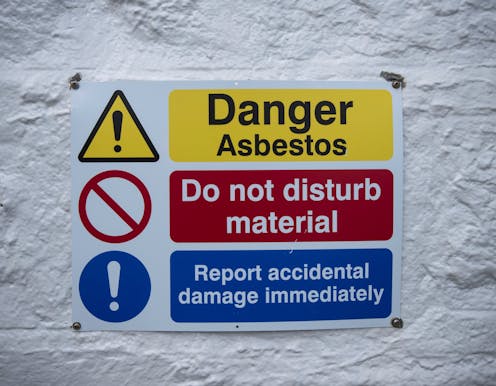
Asbestos may have been banned from use in the UK since 1999 but the hazardous material continues to pose a serious danger to the population.
Low levels of asbestos are naturally present in the air, water and soil, which usually doesn’t cause people to become ill. However, regular exposure to asbestos – in the workplace, for example – is a real health risk.
Asbestos exposure can have an insidious effect on health. It can take decades for symptoms to become noticeable but, once diagnosed, most patients die within two years.
According to the Health and Safety Executive (HSE), Britain’s national regulator for workplace health and safety, more than 5,000 people die from asbestos-related diseases each year, making asbestos the leading cause of work-related deaths in the UK.
Perilous but popular
Asbestos is a group of dangerous but naturally occurring fibrous minerals widely used for decades for their heat-resistant and insulating properties. The primary types of asbestos include the most commonly used chrysotile (white asbestos), amosite (brown asbestos) and crocidolite (blue asbestos).
These fibres are highly durable and resistant to heat, electricity, and chemical damage, which made asbestos a popular material in various industries, particularly in construction and manufacturing throughout the 20th century.
Worryingly, despite the known dangers of asbestos, it remains a common material in many UK school buildings. According to a 2019 Department for Education survey, more than 80% of state schools in England and around 60% of schools in Scotland and Wales still have asbestos “present on their estate”.
Asbestos is considered to be safe as long as it is undisturbed. However, if there are damaged or shedding fibres then the material becomes highly dangerous to those exposed to it.
An (un)healthy education
When asbestos fibres become airborne and are inhaled, they can cause significant damage to lung cells and other organs.
The main health issues linked to asbestos exposure include lung cancer, mesothelioma, and asbestosis, a chronic lung disease that leads to lung tissue scarring and severe breathing difficulties.
Mesothelioma is a rare but aggressive cancer affecting the lining of the lungs – and sometimes the abdomen or heart. Sadly, as my research has shown, it’s extremely difficult to treat patients with this condition.
HSE statistics show that 111 teachers died from mesothelioma between the years of 2011-20. In 2021, 23 teachers died from the cancer. A 2021 report by the Joint Union Asbestos Committee (JUAC), a group that was set up to protect workers and students from the risk of asbestos, states estimates that “1,000 teachers and support staff and 9,000 former pupils died from mesothelioma between 1980 and 2017 due to asbestos exposure in schools”.
Deadly decay
State school buildings constructed between the 1950s and 1999 in the UK are likely to have been built using asbestos containing materials. Despite the guidance that asbestos is safe if not disturbed, there are concerns that the dilapidated state of many of the UK’s state school buildings is causing teachers and children to be at risk of asbestos exposure.
In October 2024, the CEO of the Mesothelioma UK charity, Liz Darlison told the MailOnline that:
The ongoing presence of asbestos in our deteriorating school buildings is like a bomb that is slowly exploding. It’s an unbelievable tragedy and a national disgrace that we are not doing more to protect people, especially children.
Crumbling school buildings could disturb asbestos fibres, causing them to be released and then inhaled by teachers and students. Asbestos fibres are invisible – they can’t be seen, smelled or felt in the air or on clothes so it’s impossible to know if you’ve been exposed to it – until it’s too late.
It seems, then, that only way to finally eradicate the health risks of asbestos is to remove it from public buildings. Strict enforcement of regulations, public education, safe removal programs and support for those who’ve been exposed to asbestos will be essential in ensuring that asbestos related health risks are finally eradicated.
Justin Stebbing does not work for, consult, own shares in or receive funding from any company or organisation that would benefit from this article, and has disclosed no relevant affiliations beyond their academic appointment.
This article was originally published on The Conversation. Read the original article.







